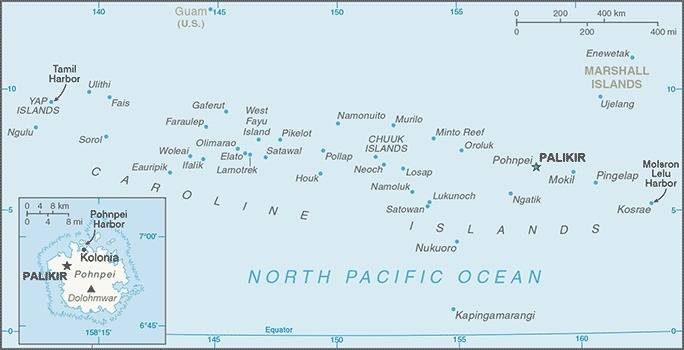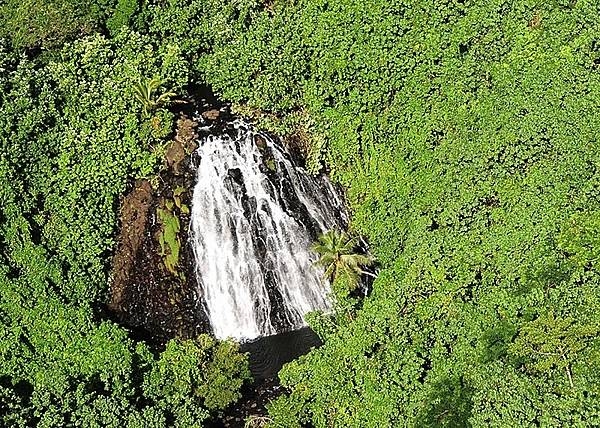41 Micronesia

Light blue with four white five-pointed stars centered. The stars are arranged in a diamond pattern. Blue symbolizes the Pacific Ocean, the stars represent the four island groups of Chuuk, Kosrae, Pohnpei, and Yap.
Flag courtesy of the CIA World Factbook

Map courtesy of the CIA World Factbook

An aerial view of Keprohi Waterfall on the island of Pohnpei. Given the high volcanic topography and heavy rainfall of Pohnpei, there are a number of scenic waterfalls on the island.
Photo courtesy of the CIA World Factbook
Government
According to Britannica, under the 1979 constitution, the government of the Federated States of Micronesia consists of executive, legislative, and judicial branches. The president and vice president are elected by the legislature, the unicameral National Congress. The legislature comprises one at-large senator from each state, who serves four-year terms, and a variable number of single-district senators (determined on the basis of population), who serve two-year terms. Most major governmental functions other than those relating to defense and foreign affairs are carried out at the state rather than the national level. Each of the four state governments has a popularly elected governor and a unicameral legislature. There are no political parties.
The judicial system consists of the Supreme Court of the Federated States of Micronesia, state courts in each of the four states, and municipal courts in each political subdivision of each state. Recognized customary law is in force wherever it does not conflict with constitutional law.
Division of Civil Aviation
The Federated States of Micronesia Division of Civil Aviation is a branch of the Department of Transportation, Communication & Infrastructure of the government of the F.S.M. and is responsible for the nation’s airspace, airports, and airfields.
Airspace
SkyVector – Google Maps – ADS-B Exchange
ICAO countries publish an Aeronautical Information Publication (AIP). This document is divided into three parts: General (GEN), En Route (ENR) and Aerodromes (AD). ENR 1.4 details the types of airspace classes they chose to adopt from classes A through G.
Drone Regulations
None found by the author.
However, should you, the reader, happen to stumble across something to the contrary, please email the author at FISHE5CA@erau.edu and you may be mentioned in the ACKNOWLEDGEMENTS section of this book by way of thanks for contributing to this free eBook!
Advanced Air Mobility (AAM) Regulations & Policies
None found by the author.
However, should you, the reader, happen to stumble across something to the contrary, please email the author at FISHE5CA@erau.edu and you may be mentioned in the ACKNOWLEDGEMENTS section of this book by way of thanks for contributing to this free eBook!
Advanced Air Mobility (AAM) News
None found by the author.
However, should you, the reader, happen to stumble across something to the contrary, please email the author at FISHE5CA@erau.edu and you may be mentioned in the ACKNOWLEDGEMENTS section of this book by way of thanks for contributing to this free eBook!
Short Essay Questions
Scenario-Based Question
You have been hired by a Drone Startup Company. Your boss has immediately assigned this job to you.
They need you to prepare a one-page memo detailing the legalities of using a drone at Keprohi Waterfall, pictured above.
They need you to mention any national laws and local ordinances.
They specifically want to know what airspace (insert pictures) you will be operating in and whether or not you need an airspace authorization.
Does it matter whether or not you are a citizen of the country?
Lastly, there is a bonus for you if, as you scroll through this chapter, you find any typos or broken links!
Short Essay Questions
- What are the drone categories?
- How is registration addressed?
- How is remote ID addressed?
- What are the model aircraft rules?
- What are the commercial drone rules?
- Are there waivers or exemptions to the rules? If so, for what?
- Would you share a link to an interactive airspace map?
- How is BVLOS addressed?
- How can you fly drones at night?
- How can you fly drones over people?
- Where do you find drone NOTAMs?
- What are the rules for drone maintenance?
- What are the rules for an SMS program?
- What are some unique rules not mentioned above?
- What are the C-UAS rules?
- What are the AAM rules?

